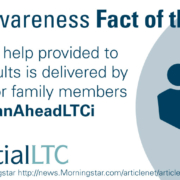Minnesota Life SecureCare – Combination Life and Long Term Care Insurance
Click Here for Your Long Term Care Insurance Quotes

Smart Planning for Long Term Care
For most people, one of their main financial goals is to plan for a retirement that allows them to live their lives to the fullest.
While not the only health challenge as we age, we are increasingly aware that many American’s face the risk of developing Alzheimer’s disease or other chronic illnesses. Providing care to those suffering from this terrible disease is expensive and poses a financial risk for families who grapple with providing for care to loved ones.
Today, it’s estimated that more than 5 million American’s suffer from this disease.
By 2050, the Alzheimer’s Association estimates that number will rise to 16 million.
The association estimates than an American is diagnosed with Alzheimer’s disease every 65 seconds.
Many people often confuse covering the costs associated with medical conditions as long-term care. However, long-term care is the need for assistance or supervision with the activities of daily living – which may or may not be caused by a medical condition. These activities include eating, bathing, toileting, transferring, dressing and continence. If you lose the ability to perform, without substantial assistance from another person, at least two activities of daily living for a period of at least 90 days-or require substantial supervision to protect you from threats to health and safety due to a severe cognitive impairment like Alzheimers or stroke- long-term care protection can help you cover the costs.
There are two main categories of long-term care services:
Home and community-based services include things like adult day care or informal care provided by a loved-one. Facility based services are those services we usually think of when referring to long-term care: assisted living, hospice or nursing home care.
Now let’s take a look at how much these services cost and the impact it could have on your savings should you need some type of care in the future.
The National Average annual cost of nursing home is $92,376. For assisted living, the annual cost is $43,536 and for a home health aid, the hourly cost is $20.50.
For many people who are thinking ahead to retirement, these numbers are a bit intimidating and if you have to pay for these costs out of pocket-it can have a dramatic impact on your retirement savings.
What are some different ways you can help pay for future care?
There are 4 main ways to pay for care. You can choose to self-insure, depend on family to help with caregiving responsibilities, some government programs or purchase insurance. Let’s take a look at the benefits and considerations of each of these options.
If you choose to self-insure you can maintain control of your assets and choose where and what type of care you’d like to receive based on how much you want to pay. If you need care, there could be tax consequences depending on where you choose to withdraw your money. Also, paying for care out of pocket could affect your or your partner’s way of life by depleting assets and/or income. This could also impact how long your money will last and you could run the risk of running out when you need it.
If your family is willing and able to help provide care that could be a helpful alternative. However many times one may not want to place that burden on their family members as it could cause undue stress to their partner or children’s lives. Also, depending on the care needed, many informal caregivers lack the skill set to provide quality care. There is also a financial and emotional toll on caregivers as many times they are paying out-of-pocket for expenses such as gas to go to doctors appointments, taking time off of work, or helping cover things insurance doesn’t pay for.
With Medicare you may receive coverage in a skilled care facility for short-term nursing home care or rehabilitation after an illness that resulted in a hospital stay. It no longer provides coverage for care in the home, long-term stays in a facility, or help with personal care needs such as dressing and bathing. Medicare does not cover any long-term care expenses after 100 days.
Medicaid is a government program for those with limited financial means. It may pay for long-term care expenses but generally only those received in a facility and only after spending down your assets.
Purchasing a hybrid life/LTC insurance, like SecureCare, can be an attractive alternative for those that may be considering self insuring. Using insurance to cover the costs of care allows you to leverage your dollars. When you self-insure each dollar that you’ve saved will pay for just one dollar of long-term care services. Leveraging your money through either a lump sum or a series of fixed payments can provide more in LTC benefits than you paid in. This option also gives you additional benefits if you don’t use it for LTC or change your mind and want your money back down the road. Let’s take a look at how this works.
Carol has been saving for 35 years. As she nears retirement she is concerned about the impact rising health care costs could have on her family and her retirement savings along with the potential she may need some type of care in the future.
If Carol needs care, her total LTC benefits will far exceed her premium payment. The addition of inflation protection allows her coverage to keep pace with rising costs and the coverage will allow her to preserve her retirement savings and maintain her independence.
Let’s talk about guarantees- SecureCare provides guaranteed benefits for you and your family:
- When you die: An income, tax-free death benefit is paid to your beneficiaries upon your death.
- If you need long-term care: A portion of your policy’s total benefit amount is paid out monthly upon meeting the policy’s eligibility requirements. Even if you exhaust all long-term care benefits, when you die, your beneficiaries will still receive a minimum tax-free death benefit of 10% of your life insurance face amount or [$10,000], whichever is less.
- If you want your money back: You may elect to discontinue coverage and may receive a premium refund.
If you can no longer pay your scheduled premiums: Your policy provides a reduced paid-up, nonforfeiture benefit, which purchase paid-up insurance for the rest of your life.
In working with your advisor on designing a policy you will want to ask yourself; What type of care do you want, how much do you want each month, and where do you want to receive care? This will help determine what premium and type of policy is right for you.
Once you have thought about the questions on the previous slide you can determine how and how much you want to pay, how long you want benefits, and if you want to add inflation protection to keep up with the rising costs of care.
Should you need long-term care benefits down the road, there are a number of services that are covered by SecureCare that allow you to be flexible in your approach to selecting the level of care that is right for you.
Benefits & services such as Skilled Nursing Home Care all the way to Informal care-which is a benefit to a cash indemnity policy like SecureCare. We’ll get more into the differences between reimbursement style plans and indemnity plans on the next slide and the impact it could have on getting the most out of your benefits.
The important note to takeaway is that should you require benefits, this type of hybrid product allows you to customize the level of care right for you, when you need it.
As we discussed previously, SecureCare is a cash indemnity style policy, this means that once you are certified as a chronically ill individual, have met any other eligibility requirements, and your claim is approved you receive a monthly benefit for as long as you remain that way.
Nothing is required to be submitted on a monthly basis and with no restrictions on how benefits can be used, including informal care, you may be able to access your benefits faster, allowing you to decide where, when and how you want to be cared for!
Let’s recap our discussion today.
Planning for your future includes considering your need for care down the road. With the possibility of an increasing lifespan and complex heath care needs, preparing means you can have more confidence by addressing these realities today.
New, hybrid insurance products, like SecureCare, can provide you with more flexibility should you require care.
You can customize an approach that works for you, to provide the guarantees that allow you to plan for your future.










